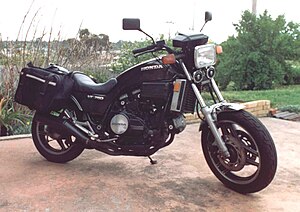
The Honda VF and VFR series is a range of motorcycles first introduced in 1982 by Honda featuring V4 engines.

The Honda Magna is a cruiser motorcycle made from 1982 to 1988 and 1994 to 2003 and was the second Honda to use their new V4 engine shared with the VF750S Sabre and a few years later a related engine was fitted to the VF750F 'Interceptor', the later models used a retuned engine from the VFR750F with fins added to the outside of the engine. The engine technology and layout was a descendant of Honda's racing V4 machines, such as the NS750 and NR750. The introduction of this engine on the Magna and the Sabre in 1982, was a milestone in the evolution of motorcycles that would culminate in 1983 with the introduction of the Interceptor V4. The V45's performance is comparable to that of Valkyries and Honda's 1800 cc V-twin cruisers. However, its mix of performance, reliability, and refinement was overshadowed by the more powerful 1,098 cc "V65" Magna in 1983.

The Honda Shadow refers to a family of cruiser-type motorcycles made by Honda since 1983. The Shadow line features motorcycles with a liquid-cooled 45 or 52-degree V-twin engine ranging from 125 to 1,100 cc engine displacement. The 250 cc Honda Rebel is associated with the Shadow line in certain markets.
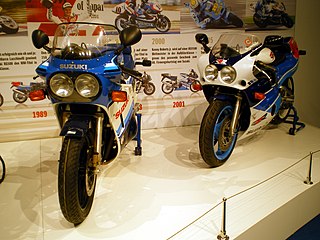
Suzuki GSX-R is a series of sports motorcycles made by Japanese automotive manufacturer Suzuki since 1984.

The Honda VFR800 (Interceptor) is a sport touring motorcycle made by Honda since 1998. The model was the successor to the VFR750F and shares the V4 engine configuration with the Honda VF and VFR series.
The GSX Series is Suzuki's range of sport touring motorcycles powered by four-valve per cylinder four-stroke engines. The first GSX models were introduced in 1980 and represented the next step in Suzuki's four-stroke road bike range after the two-valve GS Series.

The Vulcan name has been used by Kawasaki for their custom or touring bike since 1984, model designation VN, using mostly V-twin engines ranging from 125 to 2,053 cc.

The Honda VFR750F is a motorcycle manufactured by Japanese automobile manufacturer Honda from 1986 to 1997.

A motorcycle engine is an engine that powers a motorcycle. Motorcycle engines are typically two-stroke or four-stroke internal combustion engines, but other engine types, such as Wankels and electric motors, have been used.
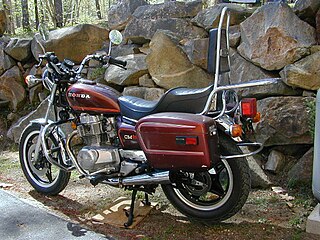
The Honda CM400 is a street bike produced by the Honda Motor Company from 1979 to 1982, part of a series of motorcycles with the prefix 'CM' using various engine capacities. It was a precursor to the Honda Rebel series of motorcycles. It was equipped with electric start and electronic ignition. Models included the CM400A, CM400C (Custom), CM400E (Economy) and CM400T (Touring). The CM400C was produced only in 1981, making it one of the rarer models.

The Honda VTX series is a line of V-twin Honda cruiser motorcycles inspired by the Zodia concept shown at the 1995 Tokyo Motor Show. The Honda VTX 1800 was launched in 1999 as a 2000 model. At the time this bike was introduced the Honda VTX engine was the largest displacement production V-twin in the world, but that distinction would be short-lived as the VTX1800 was superseded in 2004 by the 2.0-litre Kawasaki Vulcan 2000. Nevertheless, the VTX 1800 still produced better 0-60 mph and 1/4 mile times.
The Suzuki Madura was a cruiser motorcycle sold by Suzuki in 1985 and 1986. It was available with either 1200 cc or 700 cc V4 engines. It was created as a response to Honda's Magna V4 muscle cruiser and was a direct competitor with Yamaha's V-Max power cruiser, also released in 1985.
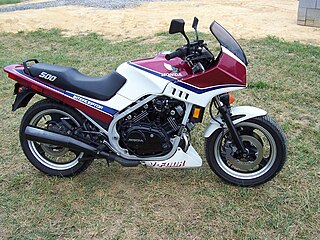
The Honda VF500F is a 498 cc (30.4 cu in) displacement sport motorcycle manufactured from 1984 to 1986. It is widely regarded as one of the finest handling motorcycles of the 1980s.
The VF500 is the Honda Motorcycle designation for its 1984-1986 498cc V-four motorcycle engine. It was used in two motorcycles, the VF500F Interceptor and the VF500C Magna V30.

The Honda CB650 is a 627 cc (38.3 cu in) standard motorcycle produced from 1979 to 1985. It featured a four-cylinder, SOHC, air-cooled, wet sump engine, with two valves per cylinder. The CB650 was a development of the CB550, itself derived from the even earlier CB500. The CB650 was the last of Honda's successful series of air-cooled SOHC fours that began in 1969 with the Honda CB750.

The Honda Fury was the first production chopper from a major motorcycle manufacturer (Honda). In a break with tradition, the Fury was the first chopper to have an anti-lock braking system The Fury's styling has been likened to custom-made choppers from Paul Teutul Sr. or Arlen Ness. The Fury has been sold not only in North America, but internationally as well, although in some markets Honda eschewed the Fury name and offered the bike simply by its model ID: VT1300CX.

The Honda VF750F V45 Interceptor aka RC15 is a sports motorcycle produced by Honda from 1983 to 1985. Using a revised engine from the Sabre/Magna with chain drive and a five-speed gearbox the half-faired motorcycle was introduced with an 86-horsepower liquid-cooled double overhead cam (DOHC) V4 four-stroke engine in a steel perimeter frame.

VT500 is a common name for the family of motorcycles sharing the Honda VT500 V-twin engine, with the cylinders set inline with the long-axis of the frame. Launched at the Cologne motorcycle show in September 1982, it was produced with various designations for different countries, such as Ascot, Shadow and Euro.

The Honda VF750F is a street bike designed by Honda from 1983 to 1985. It has an 86 hp (64 kW), liquid-cooled, V4 engine which sports dual overhead cams (DOHC). The V4's were started a year before with the 1982 Honda Magna VF750C and Sabre VF750S but were adapted for the VF750F in 1983 by reducing the six speed transmission to a five speed because of the change from shaft drive to chain. This reduced the available space in the transmission thus changing to a five speed.
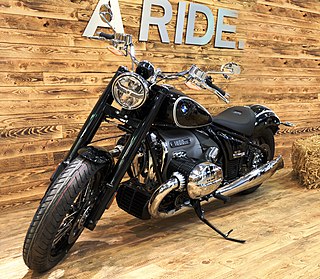
The BMW R 18 is a cruiser motorcycle manufactured by BMW Motorrad and was officially introduced in April 2020 and launched in September 2020 in Germany. Due to the COVID-19 pandemic, an official introduction at the BMW dealers was not possible, therefore it was presented virtually on the internet.
